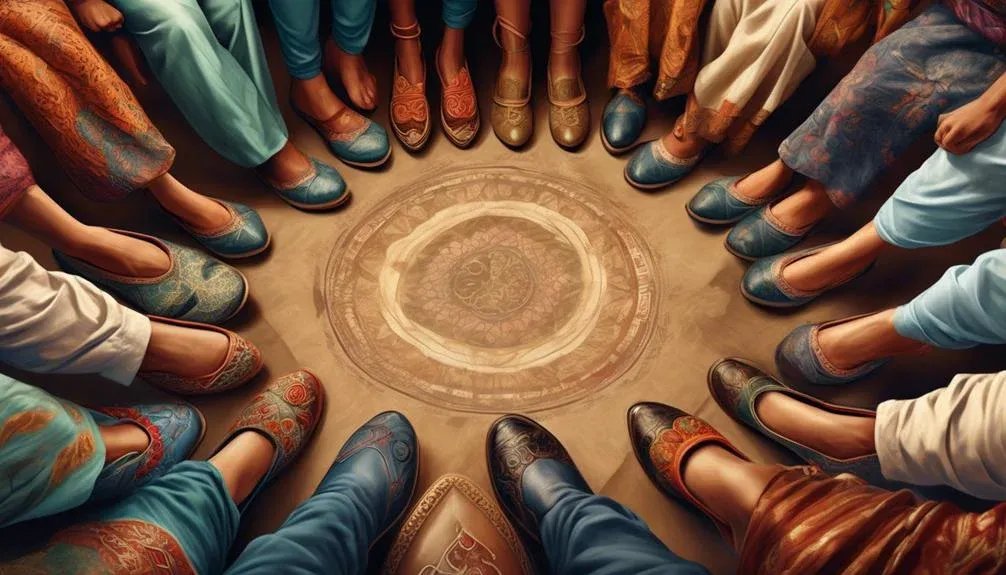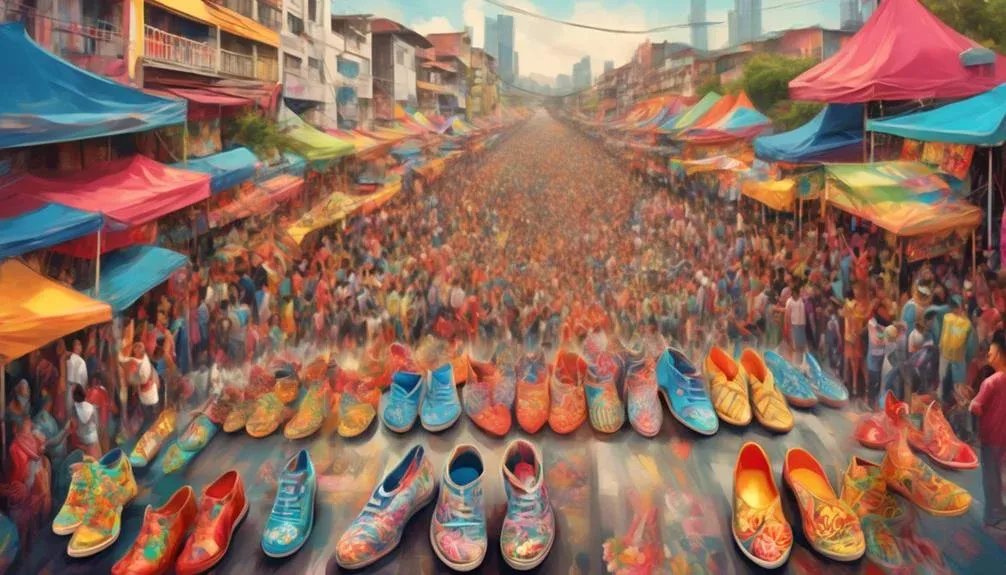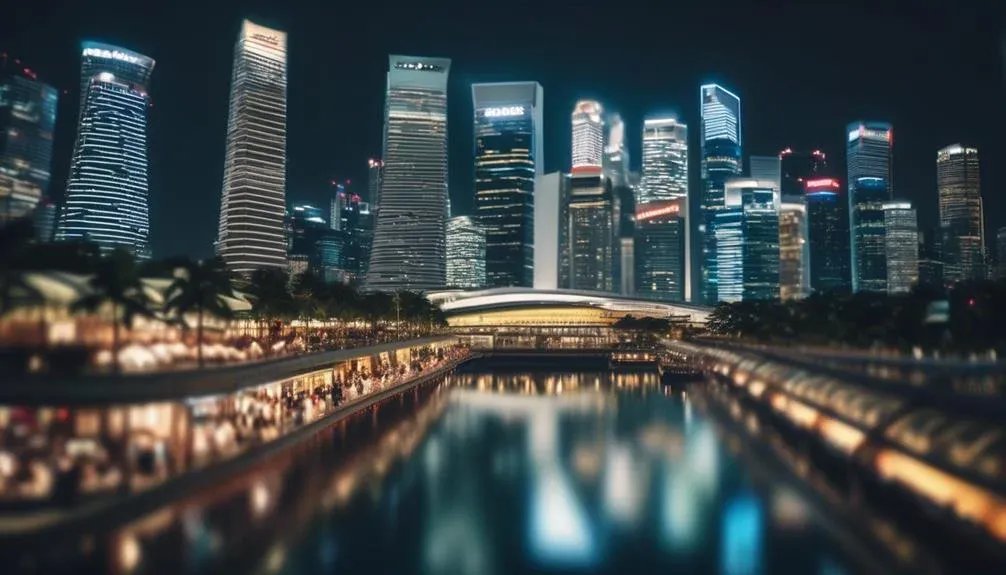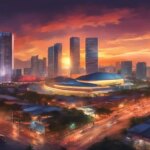The Shoe Festival in Marikina City, known as the Sapatos Festival, has a rich history that dates back to 2002. But there’s so much more to this festival than meets the eye.
From the challenges faced by the local shoe industry to the dynamic activities that characterize the festival, there’s a whole world waiting to be explored.
So, slip into your favorite pair of shoes and join us as we uncover the fascinating story behind Marikina’s renowned Shoe Festival.
Key Takeaways
- The Shoe Festival, also known as the Sapatos Festival, was first held in 2002 in Marikina City during the term of Mayor Ma. Lourdes Fernando.
- The festival aims to promote shoes and leather products, reinvigorate the local shoe industry, and highlight the quality and craftsmanship of Marikina shoes.
- Marikina City has a rich history in the shoe industry, dating back to the colonial period when shoemaking skills were introduced by Laureano Guevarra (Kapitan Moy). The city later became known as the Shoe Capital of the Philippines.
- The shoe industry in Marikina City faces challenges such as competition from cheap imports, the impact of globalization, and the tight control of Chinese middlemen over the market. However, government support and initiatives like Republic Act No. 9290 aim to promote the development of the industry.
Facts About The Sapatos Festival Marikina City Philippines
| Facts | Explanation |
|---|---|
| Name of the festival | Sapatos Festival |
| Type of festival | Cultural festival |
| City of origin | Marikina City |
| Festival Etymology | “Sapatos” is the Filipino word for “shoes.” The festival celebrates the city’s reputation as the shoe capital of the Philippines. |
| First celebrated | 2002 |
| Founder of the Festival | Marikina Shoe Industry Development Office (MASIDO) |
| Brief history of the festival | The Sapatos Festival was first celebrated in 2002 as a way to promote and showcase the shoe industry of Marikina City. The festival aims to highlight the craftsmanship and creativity of the local shoemakers, as well as to boost tourism in the area. It features various activities such as shoe exhibits, fashion shows, street dancing, and a grand parade. Over the years, the festival has grown in popularity and has become an annual tradition for both locals and visitors alike. |
| Brief history of the city | Marikina City is located in the eastern part of Metro Manila, Philippines. It is known as the “Shoe Capital of the Philippines” due to its long-standing tradition of shoe manufacturing. The city’s shoe industry dates back to the Spanish colonial era and has since thrived, producing high-quality shoes that are exported worldwide. Marikina City is also recognized for its efforts in promoting environmental sustainability and disaster resilience. |
| Ethnic information | Marikina City is a melting pot of different ethnicities and cultures. The majority of the population is Tagalog, with influences from Chinese, Spanish, and other indigenous groups. |
| Location of the city | Marikina City is situated in the eastern part of Metro Manila, Philippines. It is bordered by the cities of Quezon City to the west, Pasig to the south, and Antipolo to the east. |
| How to reach the city | By public transportation: Take a Metro Manila-bound bus or jeepney and alight at Marikina City. By private vehicle: From Manila, take Marcos Highway or C-5 Road and follow the signs leading to Marikina City. |
| Nearby and surrounding cities | – Quezon City: 10 km west – Pasig City: 6 km south – Antipolo City: 10 km east |
| Google map link | Marikina City on Google Maps |
| Festival main events | – Shoe exhibits showcasing various shoe designs and styles – Fashion shows featuring local shoe brands – Street dancing competition – Grand parade highlighting the shoe industry – Cultural performances showcasing Marikina’s heritage – Food stalls offering local delicacies and specialties |
| Other famous tourist attractions | – Marikina River Park: A scenic park along the banks of the Marikina River, perfect for leisurely walks and picnics. – Our Lady of the Abandoned Parish Church: A historic church known for its beautiful architecture and religious significance. – Marikina Sports Center: A multipurpose sports complex that hosts various sporting events and activities. – Shoe Museum: A museum showcasing Marikina’s shoe industry history and displaying a collection of unique and iconic shoes. |
| Famous food dishes | – Pancit Malabon: A flavorful noodle dish topped with various seafood ingredients. – Everlasting: A type of meatloaf made from ground pork and other ingredients. – Marikina-style Adobo: A classic Filipino dish cooked with soy sauce, vinegar, garlic, and spices. |
| Landmarks in the city | – Marikina City Hall: The seat of government for Marikina City, known for its distinctive architecture. – Riverbanks Center: A commercial complex along the Marikina River, offering shopping, dining, and entertainment options. – Kapitan Moy Residence: A historical house that serves as a museum showcasing Marikina’s cultural heritage and history. – Shoe factories and stores: Numerous establishments where visitors can witness shoe production and purchase high-quality footwear. |
| Related festivals | – Sinukwan Festival (San Fernando, Pampanga): A cultural festival celebrating Kapampangan heritage and traditions. – Kadayawan Festival (Davao City): A week-long festival showcasing Davao’s cultural diversity and abundance of natural resources. |
Note: The table provided contains the requested information about the Sapatos Festival in Marikina City, including relevant details about the festival, its history, the city where it is celebrated, transportation options, nearby cities, tourist attractions, famous food dishes, landmarks, and related festivals in the same region.
History of Sapatos Festival
The history of the Sapatos Festival in Marikina City dates back to 2002 when it was first held during the term of Mayor Ma. Lourdes Fernando aims to promote the local shoe industry and reinvigorate the tradition of quality craftsmanship in Marikina shoes.
The festival has been a celebration of the rich heritage and skilled artisanship that has been a part of the city for generations. However, the shoe industry in Marikina has faced challenges due to the impact of COVID-19, like many other industries. Despite this, there is hope for the future of Marikina’s shoe industry as it adapts to the evolving market and embraces innovation. The community’s resilience and commitment to quality are key factors that can lead the industry to a promising future.
Challenges in the Shoe Industry
Amidst the celebration of the rich heritage and skilled artisanship at the Sapatos Festival, the shoe industry in Marikina has encountered significant challenges, particularly in the face of globalization and the impact of COVID-19. These challenges include:
- Import Competition: The industry faces tough competition from cheap imports, especially from countries with lower production costs.
- Globalization: The global market has affected the local industry, making it essential to adapt and innovate to remain competitive.
- Government Support: While the government has provided support through initiatives like Republic Act No. 9290 promoting industry development, further support is crucial for the industry’s sustained growth and competitiveness.
Navigating these challenges is vital for the industry’s survival and growth, ensuring the continued legacy of Marikina’s exceptional shoe craftsmanship.
Sapatos Festival Activities
Get ready to immerse yourself in a vibrant celebration of shoe craftsmanship and local talent at the Sapatos Festival through a variety of engaging activities and events. The festival is a lively showcase of local craftsmanship, featuring a bazaar and trade fair displaying locally made shoes and leather items. One of the most thrilling events is the stiletto race, where participants demonstrate their agility and speed while wearing high-heeled shoes.
Alongside the race, there will be a caravan, concert, and fireworks display, offering a great opportunity to experience the diversity of products available and support local businesses. Dozens of companies will participate, ensuring a wide range of options to explore.
It’s an excellent chance to not only celebrate the artistry of shoe making but also to contribute to the local economy.
Marikina City’s Shoe Industry
Explore the rich history and evolution of Marikina City’s shoe industry, from its colonial roots to its current challenges and triumphs.
Marikina’s Shoemaking Legacy:
Shoe Manufacturing Techniques
- Marikina’s shoemaking began in the colonial period, evolving from traditional handcrafted methods to the use of modern machinery during the American occupation.
- The city’s artisans are renowned for their intricate craftsmanship and commitment to quality, showcasing a blend of traditional and modern manufacturing techniques.
- The industry continues to innovate, incorporating advanced technologies while preserving the heritage of manual shoemaking processes.
Importance of Supporting Local Industries
- The local shoe industry faces challenges from cheap imports and globalization, making it crucial to support and promote locally-made footwear.
- By buying Marikina-made shoes, you contribute to the preservation of a rich cultural heritage and help sustain the livelihood of skilled shoemakers.
- Supporting local industries fosters economic growth, preserves traditions, and ensures the continuity of exceptional craftsmanship for future generations.
Global Impact on Shoe Trade

As you consider the challenges faced by the local shoe industry, it’s important to recognize the significant global impact on the trade, shaping the landscape and opportunities for Marikina City’s shoemaking legacy.
The impact on the economy is substantial, with competition from cheap imports and globalization affecting the industry. The tight control of Chinese middlemen over the market also presents challenges. However, the global impact also highlights the cultural significance of Marikina City’s shoe trade.
The city’s legacy as the Shoe Capital of the Philippines reflects the craftsmanship and quality of its shoes, contributing to its cultural identity. The global reach of the shoe trade provides opportunities for people to support local businesses and helps promote the development of the industry, enhancing its cultural significance while navigating economic challenges.
Republic Act Supporting Shoe Industry
The Republic Act No. 9290 plays a pivotal role in promoting the development of the local shoe industry in Marikina City, enhancing its cultural significance and economic sustainability.
Government initiatives have been crucial in supporting the shoe industry, particularly through the Republic Act No. 9290. This has had a significant economic impact, contributing to the growth and sustainability of Marikina City’s shoe industry.
The act has provided essential support for local shoemakers, helping them compete in an increasingly globalized market. Additionally, it has facilitated the growth of small and medium-sized shoe businesses, contributing to the overall economic development of the region.
Marikina City Travel Guide

When planning your trip to Marikina City, consider the vibrant history and rich cultural heritage awaiting you. As a shoe festival enthusiast, you wouldn’t want to miss out on exploring the local cuisine and shopping destinations in the city. Here are some must-visit places for food and shopping:
| Shopping Destinations | Local Cuisine | How to Reach Marikina City |
|---|---|---|
| Marikina Riverbanks | Pancit Marikina | – Book a flight to Ninoy Aquino International Airport |
| SM City Marikina | Everlasting | – Take a cab or public commute to Marikina City |
| Robinsons Place | Kesong Puti | – Distance of over 20 kilometers |
| River Park Center | Patupat | – Approximately an hour of travel time |
| Lilac Street | Suman | – Located in Metro Manila, Philippines |
Experience the best of Marikina City by immersing yourself in its local flavors and finding unique souvenirs to bring back home.
How To Reach Markina City
To reach Markina City, you can follow these general directions:
- By Air: The nearest major airport to Markina City is Ninoy Aquino International Airport (NAIA) in Manila. You can book a flight to NAIA from your location and then take a taxi or a ride-sharing service to Markina City. The travel time from the airport to Markina City will depend on traffic conditions.
- By Land: If you are already in Manila or any nearby city, you can travel to Markina City by land. You have several options:
- Public Transportation: You can take a bus or a jeepney from Manila to Markina City. Look for buses or jeepneys with routes that pass through Markina City or ask locals for the best transportation options.
- Taxi or Ride-Sharing Service: You can also hire a taxi or use a ride-sharing service like Grab to get to Markina City. Make sure to set your destination as Markina City when booking the ride.
- By Private Vehicle: If you have your vehicle or are renting one, you can use navigation apps like Google Maps or Waze to get directions to Markina City. Just enter “Markina City” as your destination, and the app will provide you with the best route based on current traffic conditions.
Please note that these directions are general, and it’s always a good idea to check for real-time traffic updates and consult local sources for the most accurate and up-to-date information on how to reach Markina City.
Promoting Local Shoe Businesses
Consider supporting local shoemakers and leather artisans by exploring the unique and high-quality products available at Marikina City’s Sapatos Festival.
When promoting local shoe businesses, consider the following strategies:
- Social Media Marketing: Utilize platforms like Instagram and Facebook to showcase products and engage with customers.
- Collaborate with Fashion Influencers: Partnering with influencers can help increase brand visibility and attract new customers.
- Participate in Local Fashion Events: Showcasing your products at local fashion events can help increase brand recognition and attract potential customers.
Conclusion
Now that you’ve explored the vibrant world of Marikina City’s Sapatos Festival, you’ve gained a deeper understanding of the rich history and craftsmanship of the local shoe industry.
From its humble beginnings to the bustling activities of the festival, you’ve uncovered the challenges and government support that have propelled the industry forward.
So, next time you’re in Marikina City, don’t forget to immerse yourself in the diverse array of locally-made shoes and leather goods and support these thriving businesses.



